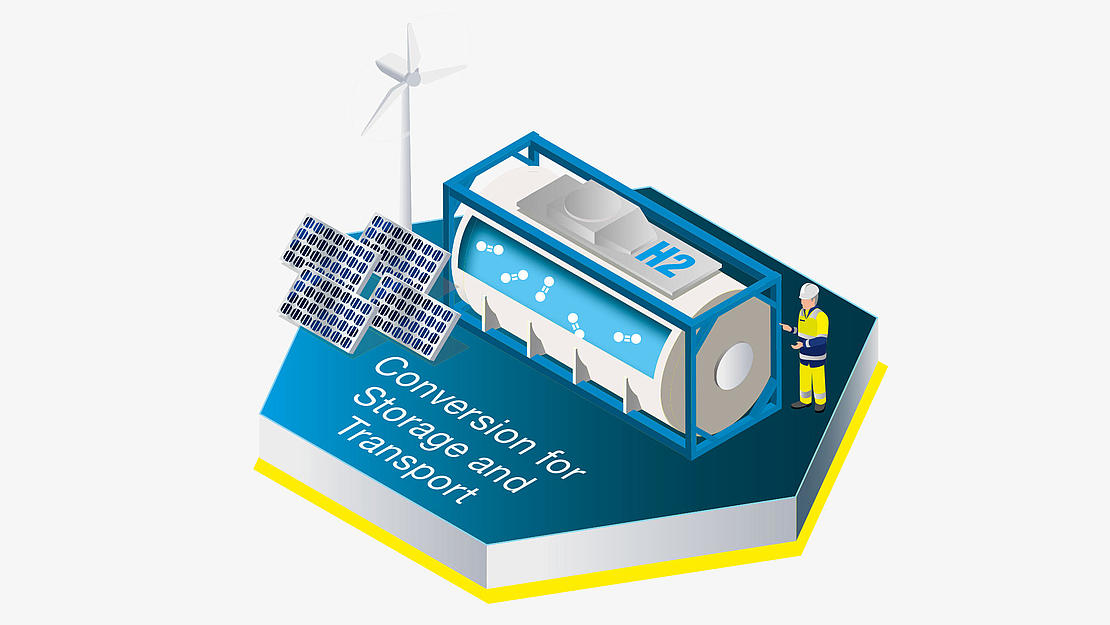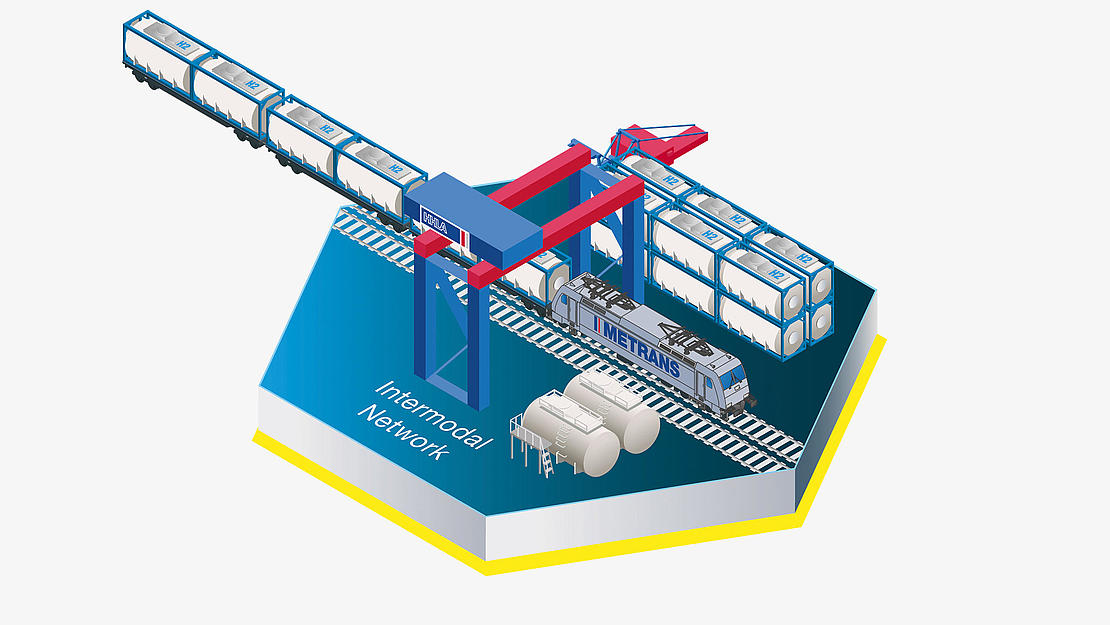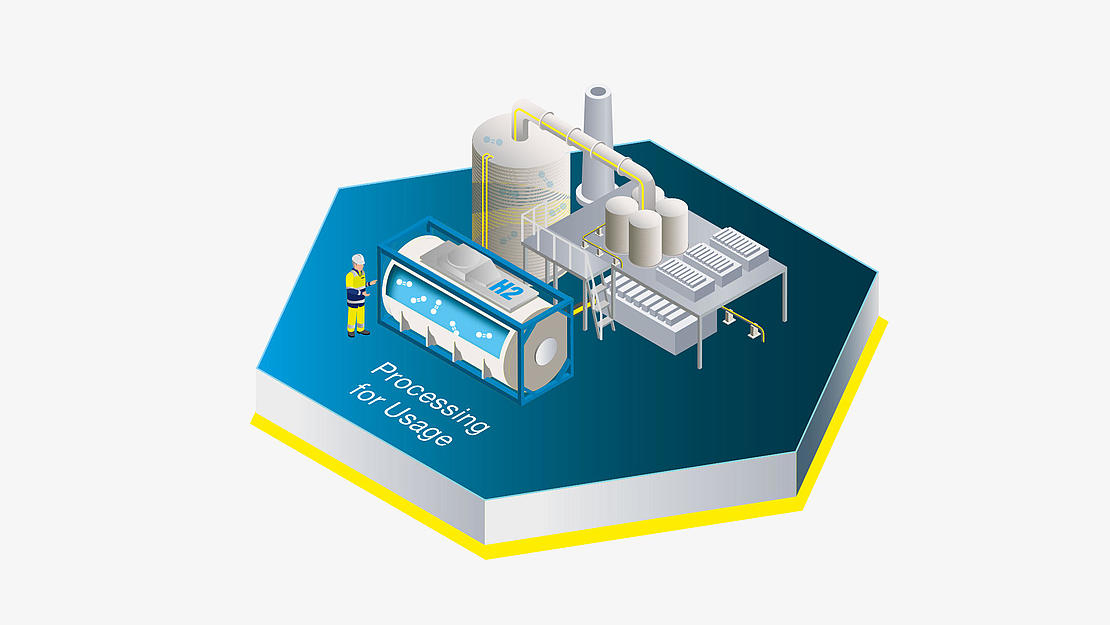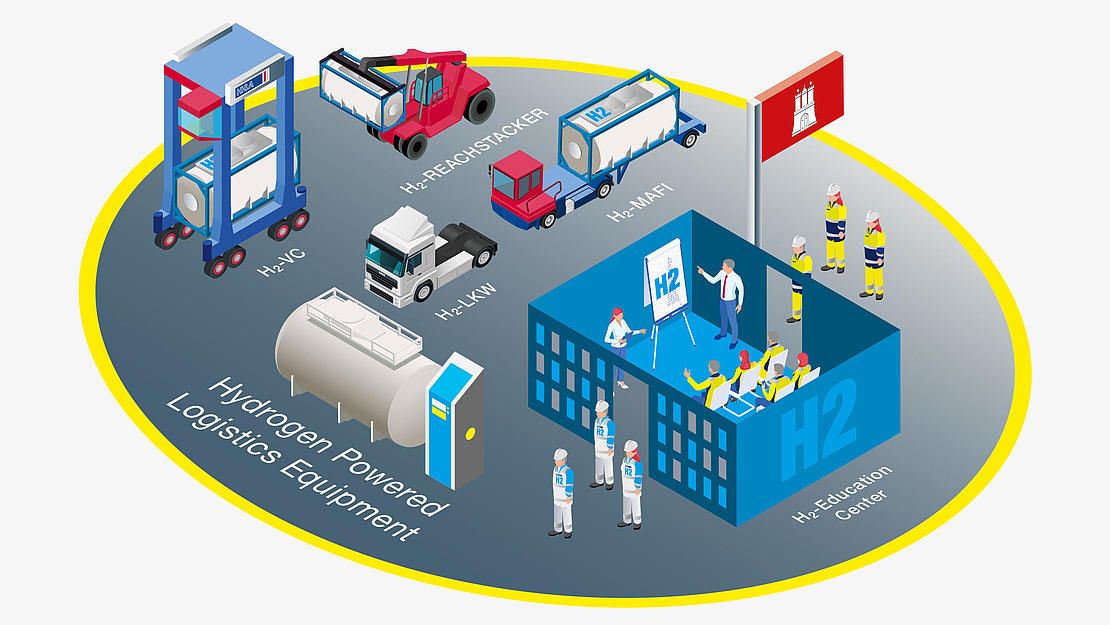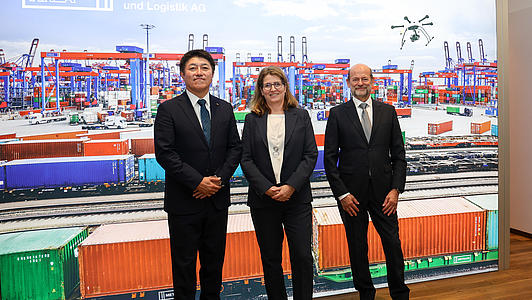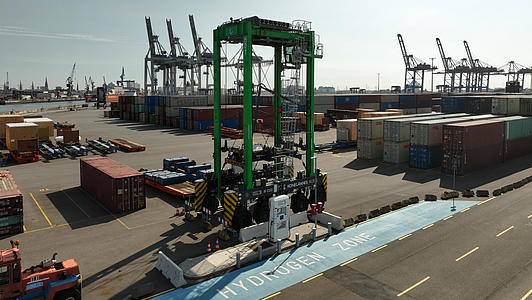The Future Potential of Hydrogen at HHLA
We want to be climate-neutral by 2040. Hydrogen can make a significant contribution to realising this goal at our port terminals. With the HHLA Hydrogen Network, the Clean Port & Logistics innovation cluster and the H2LOAD project for converting heavy-duty equipment, we are testing and validating the practical use of hydrogen in port operations. In addition, we are involved in the H2Global Foundation and are developing solutions for the international transport of hydrogen with the LH2 container project. These initiatives strengthen our expertise in the field of decarbonisation through hydrogen and lay the foundation for long-term sustainable port logistics.

Hydrogen refuelling station at HHLA Container Terminal Tollerort
Equipment such as straddle carriers, empty container stackers, forklift trucks, reach stackers, tractor units and heavy goods vehicles can be efficiently refuelled with green hydrogen at 350 bar in the Port of Hamburg.
Learn moreHHLA Hydrogen Network
In 2020, we launched the HHLA Hydrogen Network project to identify the potential of hydrogen in our own fields of business and beyond. This project provides the framework for all hydrogen-related activities at HHLA.
On the one hand, we are positioning ourselves as a logistics company in the field of hydrogen import and distribution. HHLA is very well equipped to take advantage of the new opportunities in hydrogen import and transportation because of its network of ports and connections that extend into the European hinterland. On the other hand, we are looking into implementing fuel cells in handling equipment and heavy-load road vehicles. The aim of these efforts is to contribute to the sustainable reduction of greenhouse gas emissions and other harmful emissions.

Heavy port technology to be powered by hydrogen
With Clean Port & Logistics, HHLA has created an innovation cluster to test hydrogen-powered equipment in port logistics. In order to reduce emissions in port handling and the associated logistics chains, the innovation cluster has the support of the German Federal Ministry of Transport and Digital Infrastructure (BMVI).
Testing hydrogen in operation at the container terminal

H2LOAD: Hydrogen Logistics Applications and Distribution
We at HHLA intend to decarbonise our operations in Hamburg by using heavy-duty vehicles powered by hydrogen fuel cells at our terminals and on the last mile of container traffic.
Import and distribution of hydrogen
At HHLA, we are actively involved in current projects focusing on the import and distribution of hydrogen as an energy source. All of the projects are aimed at investigating the economically feasible import and transport of the new energy source and at simplifying a market ramp-up.

Greener hydrogen for the markets.
The H2Global Foundation brings together numerous participants who want to contribute to the economic market launch of green hydrogen. The H2Global Foundation will implement a funding concept specially developed for this purpose. We have been involved in this sustainability initiative since the very beginning. Greener hydrogen for the market.
Towards the future with hydrogen
We have a clear goal: we want to be climate-neutral by 2040. Hydrogen can make a significant contribution to this. “In order for us and the logistics industry to become climate neutral, we need to test and gather experience to make the technology reliable and more economical,” says Karin Debacher, Head of Hydrogen Projects. In a short interview, she reveals the steps we are taking to make hydrogen a reality in everyday port operations.
HHLA climate blueprint for Germany and Europe
Is hydrogen-powered equipment also on the cards at HHLA?
With several hundred handling units and approximately 17,000 trucks stopping at the Port of Hamburg daily, the potential for decarbonisation is enormous. That is why we are planning an initiative in Hamburg that can be used as a blueprint for sites across Europe.
What does this plan look like?
We have founded the Clean Port & Logistics innovation cluster, which is funded by the German government. It forms an open organisational framework that aims to bring together equipment manufacturers, port and logistics companies, scientific partners, renewable hydrogen producers, software companies and operators or manufacturers of refuelling stations. Through supra-regional cooperation, we want to conduct tests and investigate how hydrogen can be reliably used as a fuel in port handling and heavy-lift logistics.
How quickly can this happen and what steps need to be taken?
First, the necessary tests, simulations, preliminary work and analyses are designed, then conclusions are drawn and training and education concepts are also developed straight away. At the core of activities is the construction of a test centre for hydrogen-powered equipment at the HHLA Container Terminal Tollerort in Hamburg. With this, we want to get the show on the road as quickly as possible.

Hydrogen in the Port of Hamburg
The future of logistics is green – and hydrogen plays a central role in this. As a European network logistics provider with seaport terminals in Hamburg, Trieste, Tallinn and Odessa, we are focusing on this key technology to make port operations climate-neutral step by step. In doing so, we are positioning ourselves globally. Together with partners, we signed an agreement in 2025 for the world's first import corridor for liquid hydrogen from Oman to Europe – deliveries are scheduled to start in 2029.
For us, hydrogen is not just a field of research, but is becoming part of our operational business. Terminal vehicles, handling technology and, in the future, trucks will be converted to hydrogen, a climate-friendly energy source. With international partnerships, investments in infrastructure and concrete pilot projects, HHLA is contributing to keeping logistics climate-neutral and competitive – in Hamburg, in Europe and beyond.
You have questions about hydrogen? We have the answers
Which properties make hydrogen attractive?
Hydrogen can be obtained by electrolysis from water and renewable electricity. The element has many uses – for example, as a base material for various products (ammonia, methanol, synthetic fuels) in the chemical industry, in transportation, in the energy sector, etc. It can be transported over long distances in various forms while being used as an energy storage system. Hydrogen is expected to relieve and stabilise power grids because it can store energy for material use, transport it, and release it any time (or anywhere) – for example, when electricity from renewable energy sources is not available.
Why is hydrogen now coming into focus?
Hydrogen has been produced for decades using proven techniques and has been primarily obtained from natural gas thus far (grey hydrogen). Vehicles powered by hydrogen or fuel cells have been actively tested since the early 1970s and are already in use, particularly in local public transport.
For a number of years, many of those involved in the energy transition have been convinced that hydrogen could replace many fossil fuels in the long term. However, this requires green hydrogen, which is generated with green electricity (wind, water, sun...). At present, however, there are not sufficient options for generating renewable energies in Europe – and especially in Germany – that would enable production of an adequate amount of green hydrogen.
The federal government’s national hydrogen strategy is thus to import hydrogen from potential producing regions (e.g. parts of North Africa, the Middle East, northern Europe) to be used in the industrial centres of Europe. As a result, there is an acute need for long-range distribution of the fuel.
Why is HHLA concerned with the topic of hydrogen?
As part of our sustainability strategy, we at HHLA are planning to become climate-neutral by 2040. As an energy source, hydrogen can make a significant contribution to the decarbonisation of HHLA. The focus is on the use of fuel cells in cargo handling equipment and in road-based heavy goods transport.
Our strategy also focuses on developing profitable growth areas along the transport flows of the future. We are convinced that hydrogen is a promising business area. With our network, which extends from various ports into the European hinterland, we are excellently positioned to seize new opportunities in the field of hydrogen import and transport.
What role does HHLA want to play?
As one of the largest providers of handling and intermodal logistics services in Europe, we at HHLA support the transformation from fossil to hydrogen-based energy sources with our know-how and suitable facilities. We are tackling the challenge of storing hydrogen and transporting it to end users in a suitable form. In addition, we are using the opportunities that arise to completely decarbonise logistics chains, for example, by increasing the use of fuel cells.
Is hydrogen dangerous?
Hydrogen is a natural element that takes the form of gas at normal environmental temperatures. Coal gas that consisted of more than 51 percent hydrogen was already used in households for heating and cooking in the middle of the last century. If an unintended leak occurs, there are usually no problems because no toxic substances are produced. However, since hydrogen is a flammable gas, the usual safety standards must naturally be observed in its handling and storage. The handling and transportation of such goods is part of HHLA’s daily business.
Latest news
Team and Contact
Head of Hydrogen Projects
Karin Debacher
Deputy Head of Hydrogen Projects
Volker Windeck
Import and Distribution
- Axel Marth
- Mara Linn Becher
Applications
- Leif Carstens
- Marie-Kristin Stussnat
- Hedda Graf
Contact
Sustainability at HHLA
It is our aspiration to combine ecological, social and economic interests in order to make our company future-proof. We underline this with our "Balanced Logistics" sustainability strategy.
Read more

